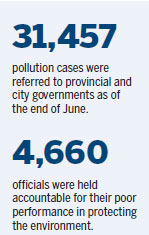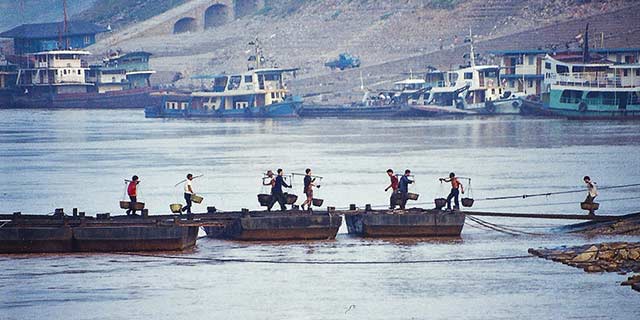Lax anti-pollution efforts highlighted
Ministry lists environmental failures across seven areas
Too much emphasis on economic growth and too little on environmental protection was identified as one of several causes of failure in the fight against pollution in Tianjin and six provinces, according to a statement on Tuesday by the Ministry of Environmental Protection.
The statement included a list of failures that were identified during a monthlong inspection, and found that some problems cropped up repeatedly.
Seven inspection teams sent by the central government in late April reviewed the antipollution performance of Tianjin and the provinces of Shanxi, Liaoning, Anhui, Fujian, Hunan and Guizhou. Detailed findings were included in the ministry's statement.

Inspectors referred 31,457 pollution problems to provincial and city governments. When inspections were completed by the end of June, 8,687 polluting companies received punishments, including fines, and 405 people were detained, the ministry's statement said.
In the seven places, 4,660 officials were held accountable for their poor performance on environmental protection. Some areas even saw pollution get worse as a result of their decisions, the statement said.
For example, the development plan of Bijie's Weining county in Guizhou province expanded the construction areas inside a national natural reserve to 16.9 square kilometers this year, from 1.5 sq km in 2009, Ma Zhongping, head of the inspection team in that province, said on Tuesday.
That runs counter to national laws protecting natural reserves, but local leaders passed it anyway, leading to severe damage, the statement said.
Shanxi province allowed the construction of some coal-fired power plants despite tough requirements from the central government to cut air pollution, it said.
In addition to slack leadership in environmental matters, many cities were found to lack infrastructure to manage waste - one of the major common problems identified by the inspectors.
In Shenyang, Liaoning province, lack of sewage pipelines and processing plants resulted in the daily discharge of 270,000 metric tons of untreated sewage.
In addition, in Guiyang, Guizhou province, more than 400,000 tons of untreated sewage was discharged into the Nanming River.
Inspectors even found that air and water quality had deteriorated in many places in the seven areas inspected, and governments failed to take effective measures to control the trend.
The central government has ordered the governments in all seven places to submit plans to rectify the problems revealed in the inspections.
Beijing, Shanghai and five other provincial-level areas that received monthlong inspections in December released their plans in July and said they welcomed public supervision as they implement the listed measures.
As of June, the central government had launched four rounds of the high-level inspections. Eight other provincial-level areas are expected to be inspected in coming months.
Because the inspectors have been sent by the central government, they have more authority than the ones appointed by the ministry, and so are considered to be a powerful tool to regulate the governments and deter polluters, the ministry said.
zhengjinran@chinadaily.com.cn
(China Daily 08/02/2017 page5)
















